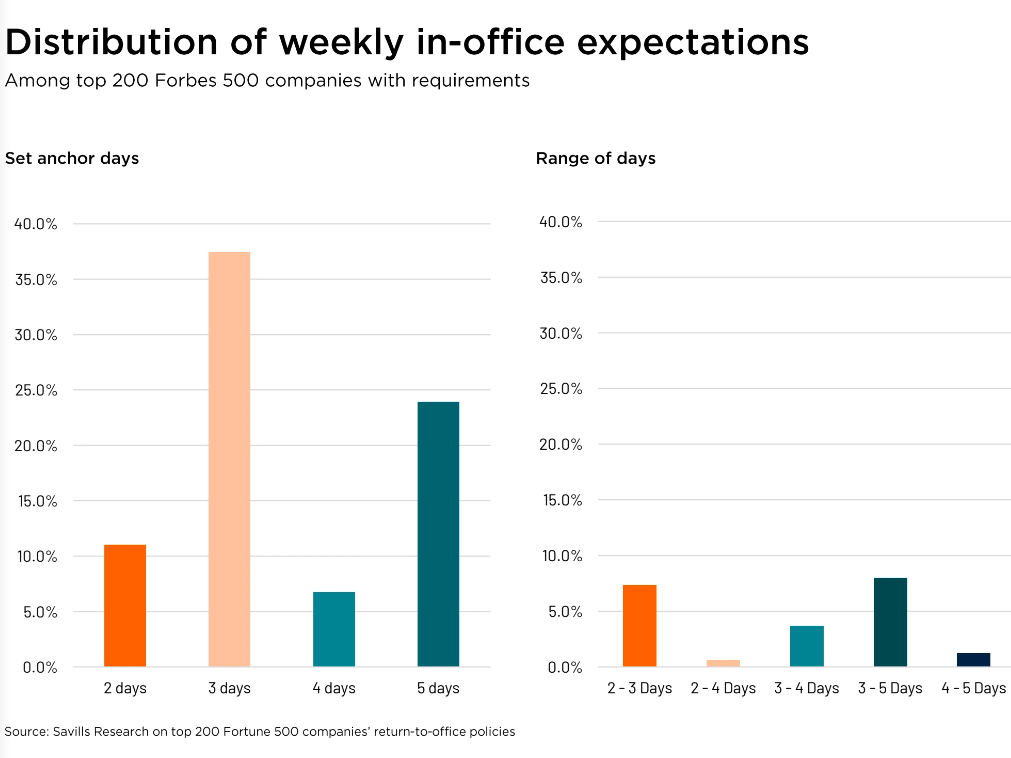Flexible Office Sector Successfully Bends Under COVID-19 Rules
Hana CEO Andrew Kupiec discusses the way increased demand for flexibility and office workers’ concerns are altering the sector’s blueprint.
The pandemic’s impact on the flexible office sector has led to unprecedented changes in employee behavior, while also triggering a restructuring of the sector’s business model. A new report from Hana, CBRE’s flex subsidiary, identified accelerated employee demand for flexibility as one of these main changes. Meanwhile, office users continue to value in-office time—realizing that random interactions with colleagues are irreplaceable.
Hana CEO Andrew Kupiec discusses the coronavirus’ effect on the flexible office sector, and other behavioral changes in office workers. He also describes their new relationship with the post-COVID-19 workspace and the future of office work.
READ ALSO: Flex Office Sector Shows Signs of Bouncing Back
The number of professionals working from home is increasing, but many still prefer the office setting. What are the factors prompting them to return to the office?
Kupiec: In our survey of more than 1,000 U.S. office workers, we discovered, unsurprisingly, that employees miss the in-person interactions with colleagues that are hard to replicate while working remotely. A large proportion of employees cite valuing meaningful in-office connections such as random conversations, in-person meetings and collaboration. It’s impossible to replicate the “water cooler” or “coffee station” moments via a remote setting, and these missed interactions are largely driving employees to look to return to the office, at least part time.
However, we also discovered that fewer employees miss the more “fun” in-office moments such as office-sponsored fitness classes and in-office games. Overall, people want to go back to the office to more effectively meet, collaborate and transfer knowledge—things that are challenging in a remote setting.
How has the office worker’s relationship with the workspace changed because of the pandemic?
Kupiec: While the office is great for meaningful in-office connections, remote work has its perks, too. Because the pandemic has forced office workers to experience some of the advantages of working remotely, they are less eager to go back to a strict 9-to-5 office schedule. Remote work has allowed many employees to forego long commutes, gain more control over their work schedule and save money.
 Predictably, our survey showed that 40 percent of U.S. employees who exclusively worked in an office before the COVID-19 pandemic are concerned about losing the flexibility to work remotely when returning to the office. Overall, Hana’s research shows that employees value remote work and the flexibility that comes with it, but that there are irreplaceable aspects of the office that they value.
Predictably, our survey showed that 40 percent of U.S. employees who exclusively worked in an office before the COVID-19 pandemic are concerned about losing the flexibility to work remotely when returning to the office. Overall, Hana’s research shows that employees value remote work and the flexibility that comes with it, but that there are irreplaceable aspects of the office that they value.
How are these changes affecting the future of office work?
Kupiec: The intersection of increased employee demand for flexible working, employer trust to work remotely and instability in future growth plans has accelerated the demand for more fluid ways of working. However, the office is not going away. Occupiers would be wise to continue to offer spaces where employees can come together to collaborate.
As companies are looking to leverage more flexible models, landlords will have to adapt accordingly. We believe landlords will look to add additional flexible options and integrate amenity offerings into their assets’ tenant structure.
How are flexible space providers getting ready to welcome workers back to their offices?
Kupiec: As of June 15, Hana officially reopened all our spaces in the U.K. and U.S. We have robust health and safety protocols following CBRE’s strict guidance for all our spaces and have been in constant communication with landlord partners regarding various protocols. We completely revisited our procedures, including the people who access our spaces and the ways in which they do so, enabling clear social distancing, providing on-site personal protection equipment and increasing our cleaning standards.
Additionally, we joined the Workplace Operator Readiness Council with 15 other workplace operators and over 20 advisers. We are all working together to ensure the health, safety and future business success of flexible space. The council enables us to set a common standard for what members can expect in our spaces and for the industry at large to further understand that flexible space will continue to not only be a viable solution for organizations but a healthy and safe one, too.
Your recent report identifies employees’ loss of flexibility as their main concern about returning to the office. What does this mean for flexible space providers?
Kupiec: Flex operators, like Hana, can help occupiers address both uncertainty in business growth and the demand from employees for workplace flexibility and collaborative workspaces. With many people acclimating to remote working, we are already hearing from occupiers looking to leverage more flexible models. We’ve closed several deals during the shutdown in both the U.S. and the U.K. for larger team suites, and we have continued to have strong interest and conversations for all our units. The demand is not just from larger companies either—we have seen a number of individuals looking for a place to escape their busy homes.
READ ALSO: CPE’s Coronavirus Coverage
How can companies that have invested significant capital in their workspaces stay afloat after most of their space became vacant due to remote work policies?
Kupiec: There is still a demand for office space for employees to connect and collaborate with coworkers. Our survey pointed out that people view in-person meetings and chance encounters with coworkers as difficult to replicate online. Companies that adopt forward-thinking workspace strategies that emphasize flexibility and effective meeting and group workspaces will be best-positioned for future success.
However, there is no one-size-fits-all approach, as many companies are considering various working arrangements for their employees. In general, they will want to ensure that their employees have enough space to feel healthy and safe, and recognize that the office needs to enable collaboration and connections across departments. As many people now have the ability to work remotely, they won’t choose to commute to the office to sit by themselves all day in a cubicle.
Tell us more about your company’s short- and long-term plans.
Kupiec: CBRE continues to invest in Hana and is quite bullish on the future demand for flex. Hana has either already opened or signed commitments for 10 open and operational units by the end of 2020. Hana can deploy additional capital to begin the planning and development of locations outside of those 10 units, but due to delays in construction and supply chain, we are not committing to additional units being open and operational within 2020.
In regard to expansion, we are absolutely looking at future global opportunities. We’re evaluating how we can support both owners and occupiers who may be challenged working with other flex space providers, as well as match accelerated demand for flex from both our Fortune 1000 clientele and portfolio investors.
How do you think the flexible space sector has changed since the outbreak, and what does the future hold?
Kupiec: Before COVID-19, occupiers who were lucky enough to have flexible space in their building were able to use the amenity as overflow space. This enables them to have their employees in one building, as their headcount and needs fluctuated. As an additional benefit, this enables occupiers to have access to the flex provider’s amenities, and it can save capital.
Now, with many occupiers uncertain about their future headcounts and space needs, we foresee flexible space being used as overflow to be in greater demand, as companies rapidly evolve. Creating this fungible space will relieve the constraint of a typical 10 or 15-year lease. We foresee occupiers having flex space accounting for 15 percent to 20 percent of their real estate, not too far from now.
In order for flex providers to serve as an integrated amenity for the entire asset, landlords and operators will need to work more closely together. Prior to COVID-19, the industry was moving away from traditional lease structures in favor of more co-invest or management agreement models where the flex operator and landlord worked together to serve the flex space needs of the entire campus or asset. We believe the industry will further adopt more collaborative models between the landlord and operator going forward, to ensure financial and operational alignment.
Are there any unexpected office trends on the real estate landscape’s horizon?
Kupiec: We believe that occupiers will continue to explore newer, nontraditional office space solutions that address a few key areas:
- Preservation of capital: Layering on the experience elements of flex is often costly for one occupier to assume on their own. There is a bit of a fallacy that flex is inherently more expensive. When you look at the complete workplace experience, you are able to disperse some of the costs across tenants, which can save organizations significant capital.
- Operational expertise: We are already seeing a shift in how space is operated as people begin to reopen offices. Leveraging a trusted operator like Hana and CBRE to outsource your workplace experience and operations will continue to be attractive to many occupiers.
- Change management: Companies are looking at their portfolios and will likely need to make shifts in where and how people work. Occupiers are looking to leverage flex to expedite their change management.









You must be logged in to post a comment.